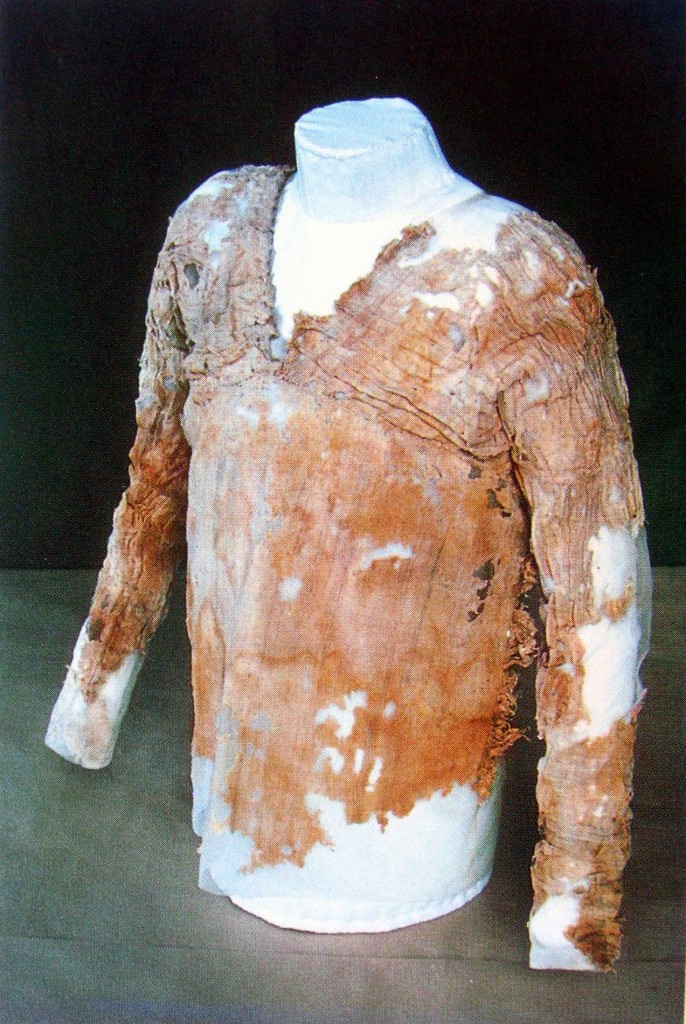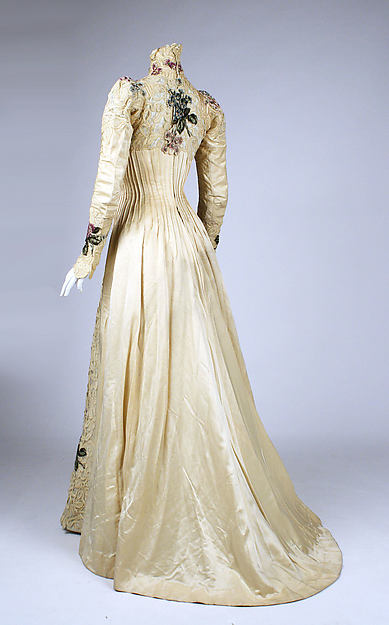February’s challenge for the Historical Sew Monthly 2016 (due by the end of Feb) is Tucks & Pleats: make a garment that features tucks and pleating for the shape or decoration.
Tucks and pleats have been used for shaping and decoration almost as long as clothing has been around. This 5,000 year old tunic is one of the (if not the) oldest extant garments, and the pleating of the sleeves is used to give it shape and interest:

Pleated tunic, Ancient Egyptian. 1st dynasty, c. 3100-2890 BC. Werner Forman Archive/ University College London, Petrie Museum
My first reasonable historical costume was a 16th century working class Flemish outfit, for which I learned to do roll-pleats, in imitation of the deliciously round, full pleats shown in paintings like Breugal’s Wedding Dance. According to my research at the time, we still don’t have any evidence that rolled pleats were used in 16th century Flanders, but they certainly do give the look.

Pieter Brueghel the Younger or workshop (1564—1638), Peasant Wedding Dance, Replica of a lost work of Pieter Bruegel I, known from an engraving by Pieter van der Heyden, 1610
The large cartwheel tuck of turn-of-the-17th century fashion is something that I am still not brave enough to tackle. It both fascinates and revolts me – but if I could replicate Arabella’s spiderweb embellished skirt, I’d definitely attempt it!

Lady Arabella Stuart by Marcus Gheeraerts the Younger, Norton Simon Museum, Pasadena, Ca, ca. 1605-10
You cannot possibly have a discussion of pleats and tucks without a robe a la francaise – I am more than a little obsessed with the so called ‘Watteau’ pleating (which may be why I have a finished francaise, two half-started ones, a finished pet-en-l’aire, and fabric for three more… 

Dress, petticoat, and stomacher (dress) possibly Dutch, About 1735; dress restyled about 1770 France, Museum of Fine Arts, Boston
The 18th century did exceptional pleating in so many ways, like the trim on this hat:
Just look at the phenomenal pleat work on the back of this evening robe:
Continuing on my quest to include this in as many Rate the Dress inspiration posts as possible, the beautifully tucked paisley petticoat:
This dress wasn’t the most popular when I posted it as a Rate the Dress, but I still think that the way the shaping is achieved almost entirely through the use of tucks throughout the torso is amazing.
The loose pleating on the right fashion sketch inspired my tea gown:
And, of course there is Emily’s heavily pintucked dress with pleated ruffle:

Evening dress worn by Mrs Emily Jane Mildon (nee Whitley), 1902-1904, Collection of Te Manawa Arts and Cultural Centre
To finish, pleats for men and women in the back of their jackets:







Ok, how do you know that the dress was originally from the 1730s? Then how do you know it was restyled? How was it restyled? Inquiring but not educated minds, people!
We know the fabric was from the 1730s from the style and weaving methods, and we know that the current look of the dress conforms to later 1770s fashion rather than 1730s based on differences in fashionable cut and trims. I’m guessing, because I haven’t actually seen the dress, that if you could see it in person there is also evidence of unpicking and re-sewing to alter the dress for fashions 50 years apart. Re-styling is really common in 18th century fashion, so there are a lot of telltale signs once you’ve seen a few that have been restyled. This is one of my all-time favourite 18th century gowns, and I would LOVE to be able to inspect it in person.
How did weaving change? What were the different trims?
This should help explain the weaving a bit: https://thedreamstress.com/2015/09/terminology-what-are-bizarre-silks/
What dress are you referring to?
Costume is usually dated from paintings depicting the fashion of the day corroborated with historical writings. i.e. A Renaissance painting of a man in armour standing with three nudes showed his armour with a particular style of pointed shoe covering that was only fashionable for approx. three months.This was early in the 1500’s and no rich man of the day would have his portrait painted in anything but the most fashionable style.
I am so lucky to have has so many neato answers. Thank you!
I like the pleat in the shooting woman’s skirt, too. Clever. Buttons closed for the slim skirt look, but is able to be opened when a gel is striding forward to discharge her firearm.
(Just a little comment about “bergère” : the accent is coming down, not up like “bergere”)
Thanks a lot for your articles we are all reading with a lot of interest. We don’t allways have something to say, but it’s very good of you to allow us to grow our culture.
Wow, that spiderweb ensemble is amazing. And the painting turns out to be in a museum literally a few miles from me. I think a trip for a closer look is in order…
Here’s my finished blog post, for my pleated ball gown bodice c. 1850:
http://isabelnorthwode.blogspot.co.uk/2016/02/bath-ball-beetlewing-bodice.html
Just finished! For this challenge, I completed a 19th century gown.
http://accoutrements-morag.blogspot.ca/2016/02/my-19th-century-blue-gown-hsm-challenge.html
My finished Entry: A 16th Century Pleated Tall hat
http://matsukazesewing.blogspot.com/2016/02/hsm-february-pleated-tall-hat.html
My pleated 1860s Ballgown bodice!
http://zeitenzauberin.blogspot.de/2016/02/pleat-pleats.html
Twenties’ pleats and some open questions:
https://aboutmybuttonbox.wordpress.com/2016/03/01/hsm-2-tucks-and-pleating-hatties-dress/
Late but done! http://isabelladangelo.blogspot.com/2016/03/historical-sew-monthly-challenege-tucks.html
[…] The Challenge: Challenge #2: Tucks & Pleats […]
Also late but done – my block-print 1790s dress with stacked pleats at the centre back:
http://aladyswardrobe.com/2016/03/hsm-challenge-2-drawstring-dress-with-pleats/
I took part with an 18th century ensemble
http://marenshus.blogspot.de/2016/03/hsf-challenge-2-tucks-pleatings.html